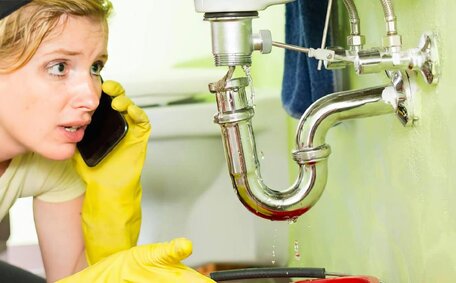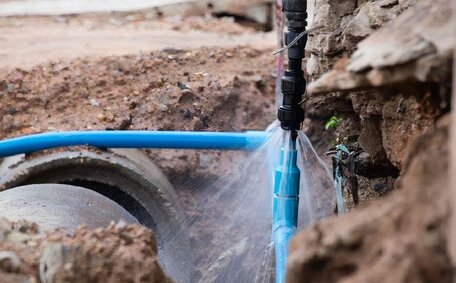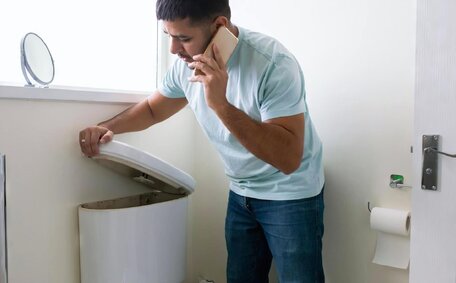Introduction: Soil, Sediment, and How They Cause Drain Blockages
Blocked drains commonly emerge from material build-ups that obstruct water flow in drain pipes, posing challenges for homes and businesses alike. Soil and sediment are primary culprits behind these blockages.
While natural processes, soil erosion and sedimentation accelerate with heavy rains. Disintegrated soil and rocks release fine particles that readily enter drainage systems.
At Northmead Plumbing, as Sydney plumbing service experts with a track record of resolving blocked drains, we pinpoint the cause—be it tree roots, grease, or soil and sediment—and deploy advanced equipment to restore optimal flow in your drainage system.
Understanding Sediment Sources and Common Causes of Buildup
There are several key sources that contribute sediment buildup in drains:
- Construction sites - Clearing land and moving large amounts of soil leads to increased erosion. Runoff from sites carries sediment that not only enters drainage systems but also affects waterways, posing a threat to the integrity of drain pipes.
- Stormwater runoff - When rains lash down, fast moving water picks up and transports eroded soil. Overland flow directs large amounts of sediment, washed away by rain, into drains.
- Soil erosion - The natural breakdown of soils produces fine sediment that contributes to blockages. This can be accelerated by the removal of stabilising vegetation.
Gradual sediment accumulation, through persistent deposition, eventually restricts water flow. As sediments settle and harden, they narrow drain pipes and create obstructions.
Interception of sediment before drain entry and strategic site planning to limit soil exposure are essential for blockage prevention.
Construction sites utilise silt fences, straw wattles, and traps for sediment control.
Home solutions include preserving vegetation, using rock walls or sandbags to stop soil, and keeping drains clear of leaves to reduce organic sediment.
Environmental Consequences of Sediment Pollution
Sediment pollution poses significant environmental threats beyond just blocking drainage infrastructure. Eroded soils that infiltrate waterways significantly diminish water quality and clarity, harming aquatic ecosystems.
Suspended sediment greatly decreases the passage of light through water, hampering the growth of plants and algae which are vital oxygen producers. Water turbidity also severely limits visibility, impacting the ability of aquatic life like fish, invertebrates and frogs to navigate, feed, breed and access safe habitats.
Excess nutrients attached to sediment particles can trigger algal blooms during warmer months. As algae spreads, decomposing organic matter depletes dissolved oxygen levels in water. This leads to fish kills and long term degradation of sensitive habitats like wetlands, mangroves and seagrass meadows.
Polluted urban runoff channels into creeks, rivers, and oceans, impacting local ecosystems. Soil erosion sources like construction sites can disproportionately affect waterways despite being physically distant from drainage discharge points.
With livelihoods and wellbeing intrinsically linked to waterway health, managing water pollution is essential. Preventing sediment from entering drain pipes through capture and containment limits widespread impacts across environments. Maintaining optimally functioning drainage infrastructure also ensures pollutants have fewer pathways into natural ecosystems.
Modern Solutions for Drain Protection From Sediments
Silt Fences
Silt fences serve as barriers to capture sediment from stormwater erosion. Installed around drainage pits, these fabrics, containing the soil, can be removed to prevent drain pipe sediment buildup. We provide and install commercial-grade silt fencing in Sydney.
Stormwater Swales
Swales, vegetated channels, convey and naturally purify stormwater. We construct tailored swales for properties across Northmead.
Native grasses in swales reduce water speed, enabling sediment settlement, and together with the soil’s natural biota, secure contaminants, offering a natural alternative to conventional kerbs and gutters.
Biofiltration Systems
Rain gardens, layering sand, soil, and organic matter, remove pollutants from stormwater, capturing sediment as water interacts with microbes that also absorb other contaminants. Biofilters, paired with swales, treat stormwater effectively and add value to the property.
Silt Bags: Features, Benefits and Proper Installation
Silt bags, crafted from durable non-woven geotextile fabric, offer an efficient method to capture eroded sediment and can be installed in and around drainage pits.
Silt bags offer several distinct features:
- A high flow rate capacity that filters sediment while allowing water to pass
- Designed for easy handling and replacement with loops for secure fastening inside drains
- Fabricated from UV-stabilised materials resistant to rotting and degradation
Benefits of utilising silt bags include:
- Stop sediment and silt from infiltrating stormwater systems
- Reduce blockages and buildup in drainage infrastructure
- Limit pollution from sites discharge into local waterways
- Reusable after emptying sediment-laden bags
For silt bag installation:
- Measure the pipe’s diameter to tailor the silt bags for a perfect fit
- Fasten the attachment straps securely to the openings of drainage pits
- Connect the bags to straps making sure the fabric is stretched firmly
- Regularly check and maintain the bags, especially after heavy rains
- Empty or replace the bags when they approach full capacity
As leading Sydney plumbers, we supply durable silt bags and can advise on appropriate installation to protect drains from sediment contamination.
Stormwater Treatment With Swales and Bioretention
Swales and bioretention areas combine landscaping with stormwater treatment, utilising natural processes to capture and filter sediment. This reduces the pollutant load on downstream ecosystems.
Swales are channels lined with grasses and vegetation that convey and treat runoff. The dense cover of plants slows water velocity, allowing heavy sediments like sand to settle out while fine particles are filtered. Microbes living on roots and in the soil also help adhere and biologically degrade pollutants.
By stripping sediment from flows, swales mitigate blockages in drain pipes. Capturing particles before they reach pipes avoids build up and clogging over time. Vegetation in swales also helps stabilise soils, reducing erosion across sites.
Bioretention Systems
Rain gardens, layered with organic mulch, soil, and drainage materials, feature a ponding area for enhanced filtration. As water flows down through the system, sediments and attached nutrients are physically strained while also being metabolised by soil microbes.
Bioretention areas release water with significantly lower sediment levels, preventing clogging in drainage pipes. Water fed into connected swale networks is also cleaner, enhancing any further treatment while protecting downstream environments.
As leading Sydney plumbers, we design and construct tailored swales and bioretention filters to capture sediment pollution from properties across the Northmead area. Protecting our pipes and waterways from contamination is a key priority.
French Drains: An Optimal Stormwater Drainage System
French drains, composed of gravel or rock-filled trenches, provide an effective solution for managing stormwater and mitigating soil erosion by facilitating quick water dispersion.
Benefits of French Drains
Key advantages of French drains include:
- Prevent water pooling and redirect runoff from foundations using drain pipes
- Capture and filter sediment, debris, and contaminants before they enter drain pipes
- Enable water absorption into nearby soils, reducing runoff
- Minimise erosion and reinforce soils surrounding drain trenches
- Require less maintenance than traditional piped drainage systems
Installing French Drains
Installing a French drain follows these important steps:
- Excavate a trench around the perimeter of the area to be drained
- Line the trench with geotextile fabric to prevent soil ingress
- Pour gravel into the trench, angling it towards the discharge point
- Lay perforated PVC pipe along trench to aid water dispersal
- Backfill trench with remaining gravel then replace topsoil
Professional design and installation are recommended for the best performance of French drains and erosion management. As leading Sydney plumbers, Northmead Plumbing offers comprehensive solutions to manage stormwater and flooding across the Northmead region. Contact us today to discuss tailored drainage systems for your property.
Hiring a Professional Plumber for French Drain Installation
For drainage implementations such as French drains, it’s prudent to engage a licenced plumbing professional. Despite the appeal of DIY, advanced expertise is often required due to the complexity of the task.
As leading plumbers based in Northmead, Sydney, our team brings decades of experience tailoring French drain solutions. We handle all aspects of the process including:
- Site analysis to develop optimised drainage plans
- Conducting trenching and excavations across various soil layers and landscaped areas
- Installing perforated piping at precise gradients for uniform dispersal
- Applying erosion control measures to stabilise disturbed areas
- Completing naturalisation using soils, aggregates and vegetation
By leveraging our extensive technical knowledge and specialised equipment, we guarantee correctly installed French drains integrated with other on-site stormwater systems.
Get in touch today to discuss how French drains can help manage runoff and flooding at your Northmead property. Call 1300 349 338 or email jobs@northmeadplumbingservices.com.au to book a site inspection with one of our licenced technicians.






